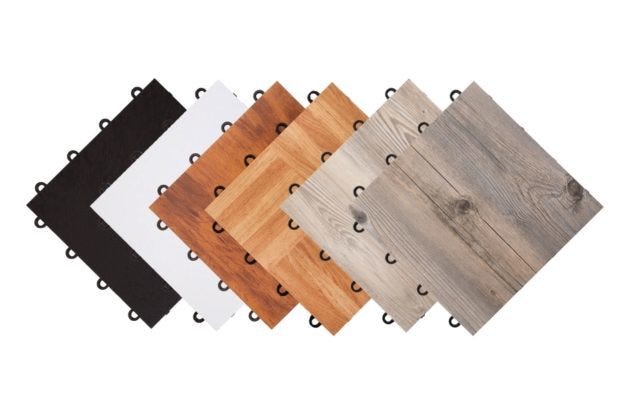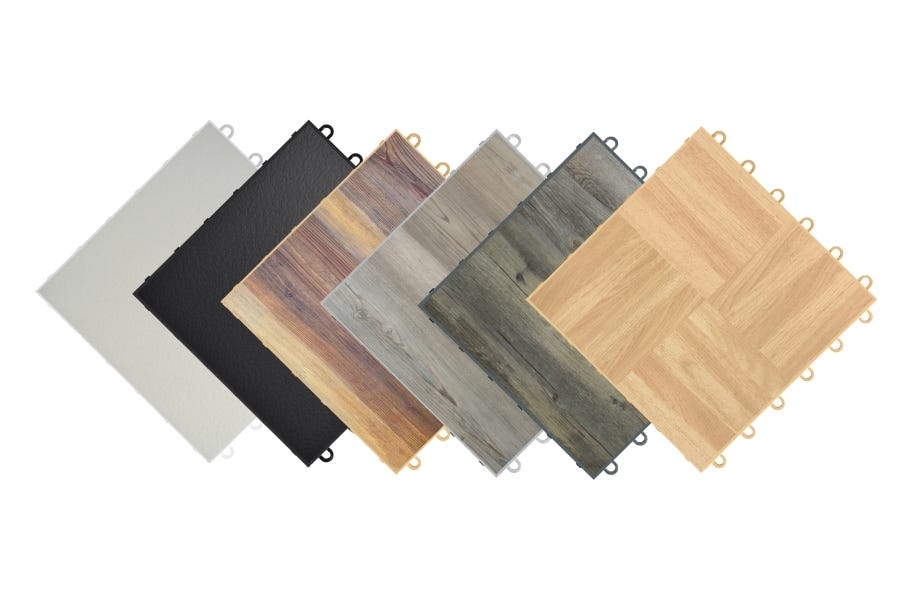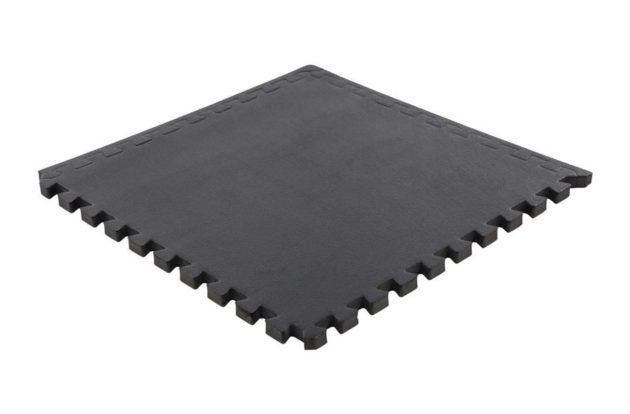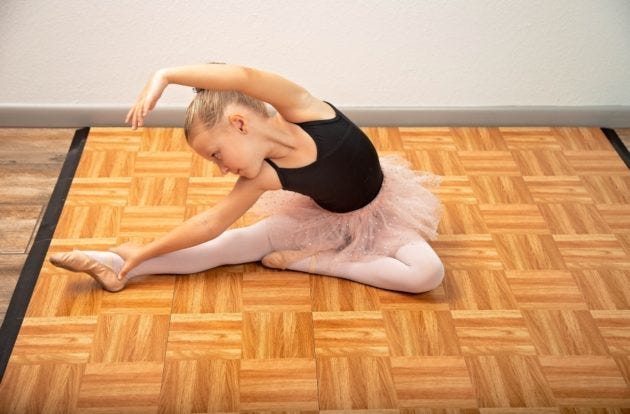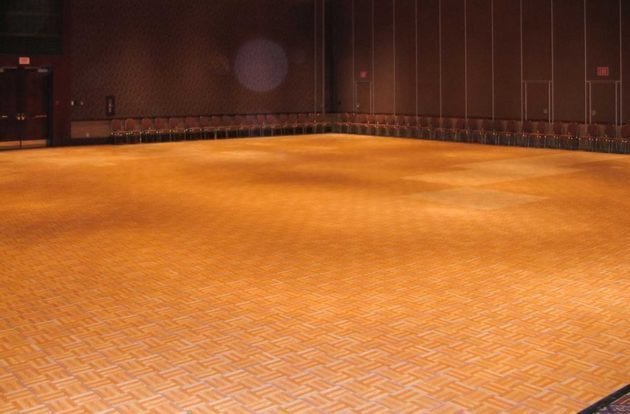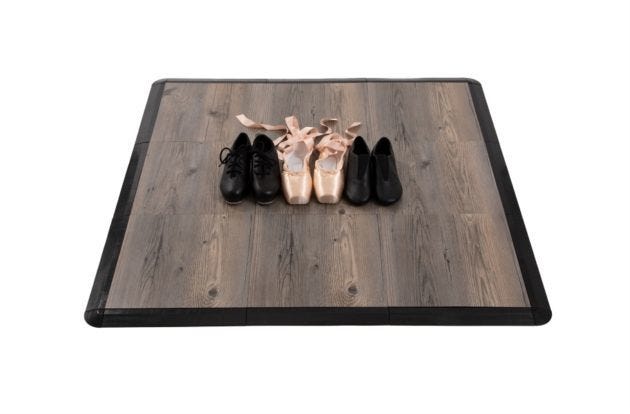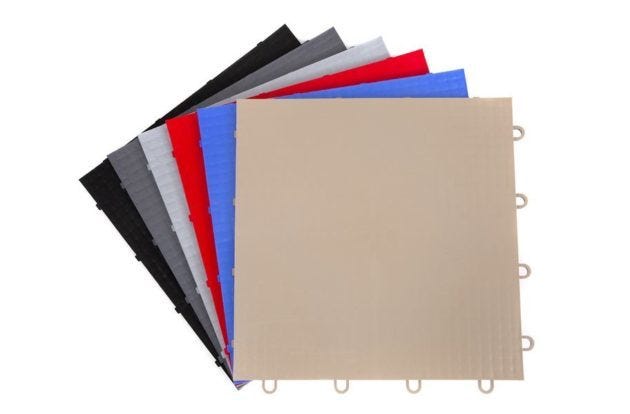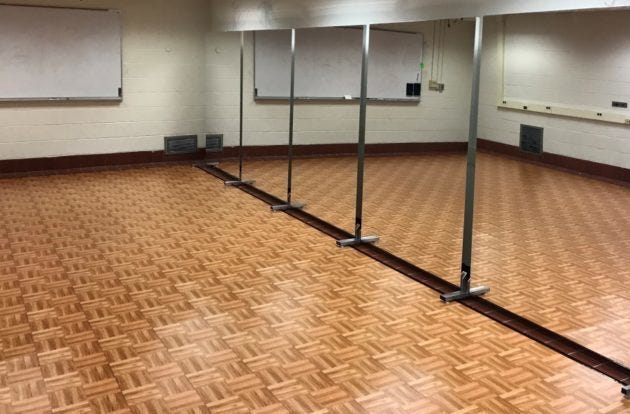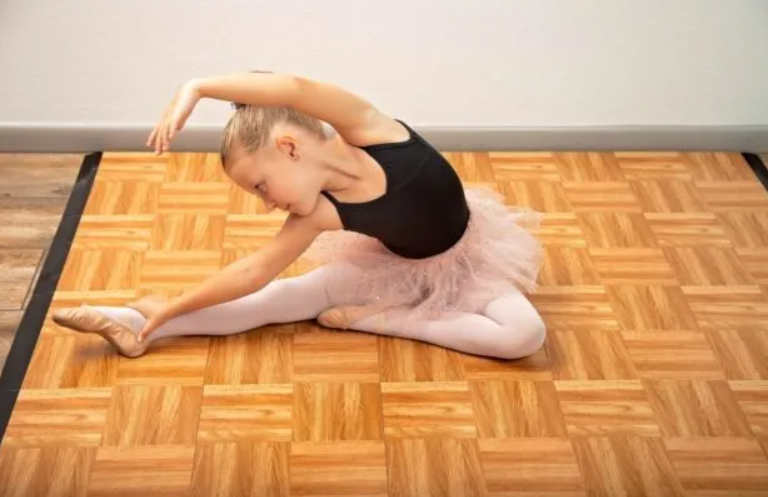
Dance floor tiles are one of the most popular temporary and semi-permanent dance flooring options on the market today! With the benefits of just enough slip and grip, acoustics, and portable size, dance floor tiles are a must.
From beginner to professional, dance floor tiles let you practice your routines and stretches with ease and grace. Find out what’s best for your at-home studio, dance company, or event planning business.
What are Dance Floor Tiles?
Dance floor tiles are a type of flooring made specifically for dancers. Dance floors are made with resilient materials that work with the dancer’s body, protect their joints from damage, and provide the perfect surface to turn and leap across.
| Related Content >> Dance Floor FAQ: 15+ Things You Need to Know |
Where Can You Use Dance Floor Tiles?
- Indoors and outdoors: Dancer floor tiles make for great inside and outside (temporary) event flooring! Regardless of your location, it’s best to use them in a cool, dry space away from water. You’ll want your dance floor to last a long time.
- Birthdays, family gatherings, weddings: Did someone say dance party? With interlocking tiles, you can expand the size of your dance floor for dozens of guests.
- Business events: Comfortable and durable dance floor tiles are not just for avid practitioners of the sport. You can use the dance floor for business events and conventions, too.
- Dance studios: Portable dance floor tiles are great for setting up different locations around the studio, especially if one of the room’s floors doesn't have the style of dance needed.
- At-home: Our variety of dance floor sizes make it easy to find the right one for your garage, basement, or spare room.
- On-the-go: Portable dance tiles are standard for warmups before dance competitions and recitals. For touring dance companies, it’s common to keep their portable dance floor handy for spur-of-the-moment practicing.
Related Content >> Portable Dance Floor Buying Guide
How to Choose Dance Floor Tiles
Before beginning your search for the perfect dance floor, there are some things you need to consider, such as the installation options and different dance floor styles. Floor tiles that are suitable for your dance style will extend the lifetime and performance of them.
Pros and Cons of Dance Floor Tiles
With every type of flooring, there are going to be notable pros and cons. Regardless of your short- or long-term goal, dance floor tiles can work exceptionally well!
Benefits of Dance Floor Tiles
-
- Acoustics: Our tap and Irish-jig-approved dance floor tiles are fantastic for clear and loud acoustics.
- Portable: The interlocking design of dance tiles makes them easy to take apart, carry, and transport. We recommend stacking them up on each other when not in use.
- Tile size: With dance tiles, you can purchase the perfect amount for your space, saving money on additional tiles you don’t need and time installing.
- Slip resistance: Unlike tile and traditional hardwood flooring, which can be too slippery, dance tiles provide just the right amount of slip dancers need for their choreography. Other flooring options are not guaranteed to be safe or sprung enough for the dancer.
Limitations of Dance Floor Tiles
- Price: The larger you want your practice dance tile floor to be, the more tiles you will need! Tiles can get pricey compared to dance floor rolls.
- Installation: Compared to dance floor rolls, tiles take more effort and time to install for large spaces. To mitigate this, we recommend having two to three helpers with you to decrease installation time significantly.
- Not as versatile: Dance floor tiles are popular for smaller spaces and social dances and may not work with every dance style, like Marley vinyl rolls. It’s best to check the manufacturer’s product specifications to ensure your dance tiles will work for you.
Dance Floor Tile Materials
Dance floor tiles are designed with ultra-durable materials that maximize the dancers’ floorwork and intent.
Unforgiving flooring, like carpet, tile, and traditional hardwood flooring, can be detrimental to the health of dancers’ joints. Invest in dance flooring that will allow you or your dancers to enjoy the sport in the long run.
Vinyl
Vinyl tiles are molded with high-grade polypropylene, which gives them resilience that dancers desire and all the benefits of a glossy and professional, wood or stone look.
Dance tiles made of vinyl are extremely popular, as they are easy to clean and require no installation tools. They genuinely are an unbeatable practice floor.
Hard Plastic
The popular hard plastic, polypropylene, creates hard, single-molded dance tile pieces. Hard plastic tiles are perfect for tap and Irish-jig, among other types of dancing.
These ultra-durable dance tiles work with almost every shoe type and can be used with or without Marley vinyl on top.
Dance Subfloors
No dancefloor would be complete without a proper sprung subfloor! Sprung subfloors distribute the dancer’s weight during leaps, jumps, and rolls so that they can continue their routines without risk of injury.
Whether you’re a part of a touring company, professional studio, or want a dance tile floor for yourself at home, you deserve to have the support you need. Luckily, there are a variety of dance subfloors you can choose from.
3/4" Home Dance Subfloor Tiles
Our home dance subfloor tiles provide balance and support for dancer’s muscles. They’re budget-friendly and great for beginner ballet, jazz, modern dance styles. With a vinyl tile floor on top of that, you can even perform tap choreography.
You can use dance subfloor tiles for permanent or temporary installations in-studio and at-home practice. Note: This subfloor is not recommended for pointe.
SHOP 3/4" HOME DANCE SUBFLOOR TILES
Premium Home Dance Subfloor Kit
With our Premium Home Dance Subfloor kit, you can easily create a soft, shock-absorbing bottom layer for your dance tiles.
The subfloor provides just the just amount of cushion and is excellent for any style and dance level. You can ensure your dance subfloor won’t wear down or become damaged when doing advanced pointe.
SHOP PREMIUM DANCE SUBFLOOR KIT
Best Dance Floor Tiles by Dance Style
Just how everyone has a favorite style of dance they love doing, dance floors have preferences, too! Pay attention to the manufacturer’s recommendations to see if your dance tiles will work for your style of dance. For each type of dance, you’ll find a popular recommendation below.
| Related Content >> How to Choose a Dance Floor |
For Jazz, Lyrical, and Ballet
These beautiful dance styles require sturdy, hard flooring to allow dancers to maximize control of their body movements.
Practice Dance Tiles
Practice Dance Tiles are great for at-home practice, studios, and events. You can purchase the perfect amount of interlocking tiles to expand your dance floor to the right amount for your space.
They come in beautiful wood looks that will surely attract you and your audience's attention. Better yet, they make for the perfect gift for an aspiring dancer in your life.
For Ballroom and Flamenco
Ballroom and flamenco require smooth and resilient flooring for intricate solo and partner dance routines — notably, these dance styles require larger floor dimensions.
Modular Grid-Loc Tiles
Our Modular Dance Floor Kits contain high-grade polypropylene and a vinyl top surface perfect for these dance styles! They’re scuff-resistant, easy to clean, and maintain their resiliency for years.
For dancers looking for a classy, traditional wood-looking dance floor, this is the perfect option for you.
For Irish Jig and Tap
Irish jig and tap dancing require specialty materials for dance flooring to ensure their floor work and acoustics stay robust.
Dancetrax Tiles
Dancetrax Tiles work well for several dance types, including tap, Irish jig, jazz, and more! They are easy to maintain, can be used outside and inside, and come in both wood and stone looks.
We know you’ll love the professional styles and portable ease of these dance floor tiles.
For Hip hop
With hip hop style, you can expect head spins, turns, and intensive movements. You’ll want heavy-duty flooring that can take that shoe work and advanced group movement.
Premium Flat Top Dance Tiles
Our premium Flat Top Dance Tiles come in various styles to express your personality or hip-hop dance routine vision. Your dance floor won’t crack or become damaged, as it’s constructed of high-impact resistant plastic,
The tiles create a solid, flat surface that easily snaps together and disassembles for multiple locations.
SHOP PREMIUM FLAT TOP DANCE TILES
How Do You Install Dance Floor Tiles?
Dance floor tiles have an interlocking system that makes them easy to install, especially if you have a couple of helpers to do the job!
Dance Subfloor Installation
- Clean your main floor of all dust, dirt, and debris.
- Install dance subfloor tiles by interlocking them to create a rectangle space. Your dance tiles will be placed on top of your subfloor.
- You can install plastic dance tiles directly on top of foam dance subfloors, requiring no adhesive or tape.
- Voila! Your dance subfloor is complete.
Dance Tile Installation
- Start at the top left corner of your designated dance floor area and place a tile with male edges (no loop) facing the top-left direction. Remember that the female sides (loops) of the tile face the bottom right direction.
- Attach your second tile to the right side of the first tile and interlock the loops. To complete an entire row, repeat step #2.
- Create the entirety of your floor by following the previous steps.
- Once you’ve interlocked your dance floor, snap the edge pieces together if you purchased them. Snap the male edges onto the floor first and finish with the female edges.
Note: When coming up to a wall, door jamb, or object, measure and cut around the tile to remove excess material. Use a tile cutter or power saw with a fine-toothed blade to ensure a smooth, polished look. Leave about 3/4” space between the wall and tiles for proper ventilation.
| Related Content >> How to Install Home Dance Flooring |
Dance Tile Maintenance
No matter how many times you tell your dancers “no shoes or snacks” on the practice dance floor, they’re still going to find a way to track in outside dirt and crumbs.
The best way to combat the grime is by cleaning the floor regularly. With minimal maintenance of sweeping/vacuuming, your floors will look clean and feel fresh every day.
Occasionally, you will want to use a heavy-duty dance floor cleaner and a soft bristle mop to get up any leftover stains. It’s essential to use a floor cleaner specifically made for dance floors, as some solutions could deteriorate the floor material instead.
How Much Do Dance Tiles Cost?
Our dance tiles start at $2.99 per square foot and go up to $6.49 per square foot, and dance floor kits start at $69.99 and up.
Keep in mind that your portable dance flooring can withstand countless warm-ups, full-blown practices, and events. Your dance tiles support the dancers’ joints, are easy to install, maintain, and create a professional surface for advanced moves.
Rest assured that the dance enthusiasts will enjoy and get the very most out of them.



